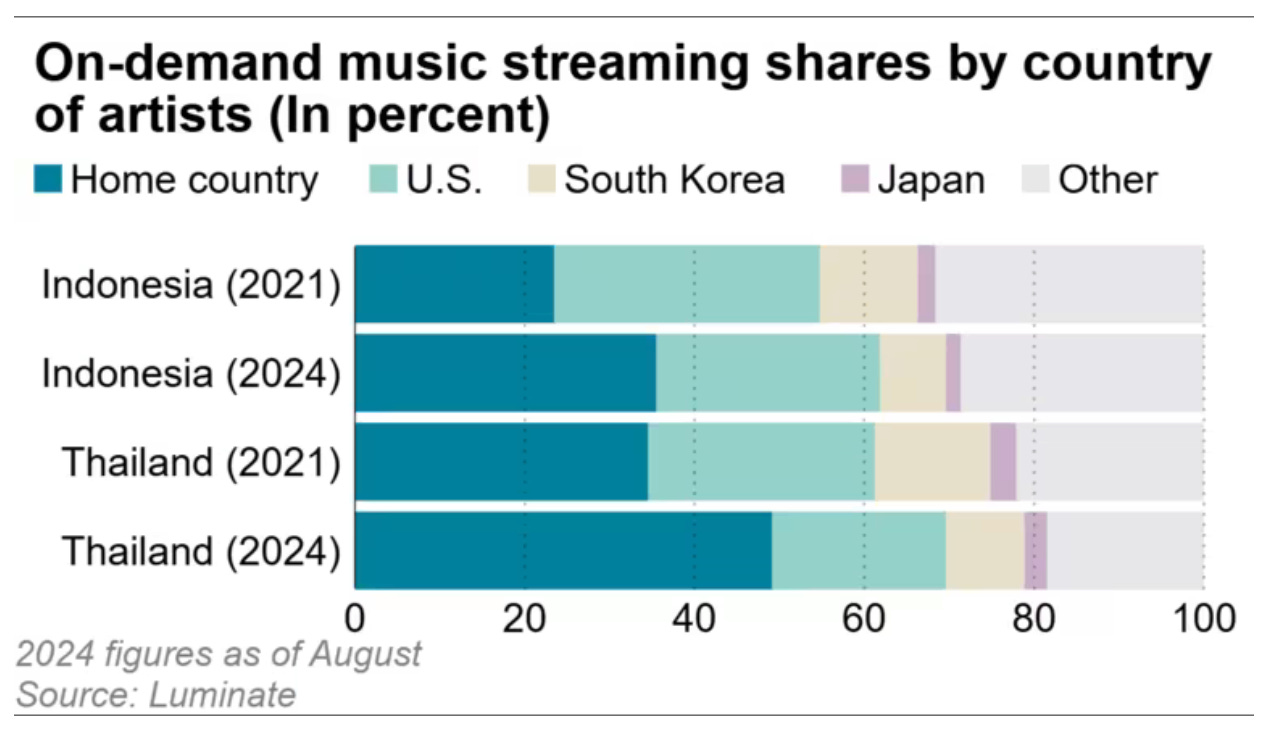#5: A snapshot of Indonesian music
Indonesia's growing music scene has a lot to offer
Thanks for reading Indonesia in English! This is the fifth edition. Welcome ☕️
If you enjoy reading this newsletter, I would really appreciate it if you could leave a comment, like this post, restack on Substack, or share with friends. Any of these actions help grow the reach of this newsletter and help me keep writing.
Let’s get started with the topic of today’s edition: music in Indonesia.
The rise of home-grown music
Recently, the AFP ran a story about British music parties in Jakarta. A DJ collective called Weekenders Service Crew started student parties based on Britpop music and is now touring around Indonesia. It looks fun and reminds me of my time at Fuzz Club indie nights at Sheffield University back in my student days.
It’s cool that music is still one of the UK's cultural exports. I used to play music in a band and have always loved listening to music from all around the world, so why not explore Indonesian music? As with everything else in Indonesia, the music scene has a dynamism and energy, which is often lacking in much of Europe these days.
In Indonesia, like in much of Asia, American music is popular, and of course, so is Korean music, but local homegrown music is gaining popularity. In March, Nikkei Asia reported on the growth in homegrown music in Southeast Asia. The article focused on Indonesia and Thailand, commenting that:
In Indonesia, once a stronghold of U.S. music, the share of homegrown tunes in on-demand streaming increased to 35% last year, up 12 percentage points from three years ago, while the share of U.S. tracks dropped 5 points to 26%, according to a study based on data from U.S.-based analytics company Luminate. The share of K-pop also declined, from 12% to 8% over the same period. Similar trends are being seen in Thailand.
This can be seen in the diagram below:

Successful songs in Indonesia and other Southeast Asian countries often spread to other Asian countries and emerging markets. But it’s tough to break through in the US and Europe. This doesn’t surprise me. In English-speaking countries and non-English-speaking European markets, it’s hard to be successful when singing in foreign languages. Artists like Bad Bunny, Rosalía, and J Balvin have been successful in recent years, especially in the US, where Spanish-language music has now become mainstream.
Artists in Indonesia enjoy a vast domestic market of 280 million, and streaming services make it easier than ever for music to reach international audiences. Since Bahasa Indonesia isn’t a tonal language, it can be easier to grasp than some other Asian languages.

Indonesian pop music can be quite ballad-heavy, but unlike Korean and Japanese music, it isn’t as distinctive. Japanese music often features similar chord progressions, and K-pop has a certain production quality and rhythm, which makes it easily identifiable. The variety of Indonesian music is a good thing, and various genres are popular in modern Indonesian music. For this post, I’ll leave aside traditional music such as Gamelan and genres with a folk element such as Dangdut.
Here’s some recent Indonesian music that’s worth listening to. Feel free to add any recommendations in the comments! I’d love to hear more recommendations from readers.
Music Recommendations
When it comes to Indonesian music, even if her style isn’t necessarily something I usually go for, I have to mention NIKI (full name Nicole Zefanya). NIKI has a vast repertoire of styles and has become a global phenomenon.
Last year, she completed a world tour, playing on four continents and almost 40 cities, including London, New York, and Sydney. NIKI is seen as someone who represents Southeast Asian music on a global stage. Her reach is definitely helped by her singing in English, and a couple of years ago, she appeared on NPR’s Tiny Desk.
Tiny Desk is a live music performance show on YouTube. Appearing on Tiny Desk was a significant achievement and certainly helped grow her global reach, given Tiny Desk’s 11 million subscribers.
Tiara Andini was the runner-up on Indonesia Idol season 10 in 2019-2020. After signing with Universal Music Indonesia, her debut track was Gemintang Hatiku (meaning The Stars of My Heart in English), a disco-inspired song that topped the local charts.
In 2024, she released Ngeluwihi, which features lyrics in both English and Javanese. Ngeluwihi was produced by a Korean production team, which can definitely be heard in the instrumentation—there is a definite Blackpink influence here.
I’d recommend Tiara Andini’s popular song from April 2024, Kupu—Kupu, which has a city pop vibe with a modern twist.
Morfem is an Indie Rock band that was formed in 2009. They have a decent following, with over 130k followers on Instagram, and they have toured Japan. But their popularity is far from that of the previous artists I’ve mentioned.
Their music reminds me of the style we’d get a lot of in the UK in previous years, but not so much these days. Whilst they have their definitive sound, I can hear influences of bands such as the Arctic Monkeys in songs such as Ngeri Yang Ku Damba (the fear I desire). I first found Morfem on a playlist online with their song Roman Rafah 2024, which has a catchy guitar line and solid rhythms, and I had to listen on repeat many times. Below is an example of Morfem’s sound:
I found the band Hindia last year. I was in a taxi in Jakarta when I heard the song Rumah ke Rumah. I only knew the song’s name because I used Shazam in the taxi; I just had to find out what the song was. Below is a live version of Rumah ke Rumah, which is really nice. After listening to Rumah ke Rumah many times on repeat, I then listened to Hindia’s back catalogue, which is generally good, but Rumah ke Rumah was the outstanding song.
That is, until this year. Earlier this year, Hindia recently released Doves: 25 on Blank Canvas, a mixtape rather than an album. A mix-tape is more experimental, less polished, and released more informally online than a usual album release. I have found Doves: 25 on Blank Canvas compelling and addictive listening, and thoroughly recommend it. The whole mixtape is available on streaming services and on YouTube (which includes lyrics on screen, and some songs are in English, fully or in part).
Hindia is actually the solo project of Baskara Putra, who also plays in a band called .Feast. If Hindia has more indie-pop sensibilities, .Feast is loud, heavy and raw. The track Arteri is exceptional. The song itself is well written, with an emotional edge, and the musicality is clear from the key change three-quarters in.
The video for Arteri is really well done. It shows a strained relationship against the backdrop of a packed gig in a small bar and the chaos surrounding it. Even if you don’t understand the Indonesian language, give it a listen and enjoy it nonetheless.
Lastly, I wanted to comment on how, in all societies, music and politics often mix.
Music and society always mix
Music is a form of self-expression, and whether subtly or directly, artists want to make themselves heard and spread their message.
A recent example of this in Indonesia can be seen with the band Sukatani. The punk band from central Java hit controversy with their song Bayar Bayar Bayar (Pay Pay Pay), which criticised police corruption.
The song was a viral success and was adopted by student protestors, which led to the band facing political pressure. Soon, the group released a video apology to the National Police Chief, which many suspected was done under duress.
The police offered the band employment. But, the band rejected the chance to serve as ambassadors for the police, and their popularity has only risen since the incident!



I’ve been trying learn more about Indonesia, but to be honest, I haven’t liked a lot of it. Maybe just not my preference I guess.
There are two Indonesian songs that I’ve found that I’ve really liked though:
Tenxi, Jemsii, Naykilla - “Garam & Madu”
MikkyZia - “Aku Dah Lupa”